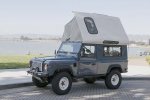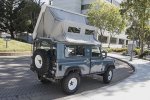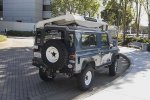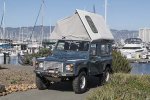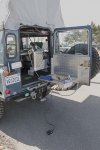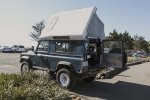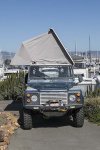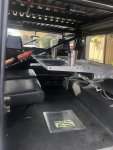Plantdriver
New member
International Powerstroke 2.8L HS Tdi engine with variable-vane turbo, and all-mechanical Bosch fuel injection.(The only electronic fuel injection component is the 12V fuel cutoff solenoid) and a full width front-mounted Allard UK intercooler. The engine has 505 miles on it. The engine swap was completed by Scott Oncken at Eco OffRoad in Sisters, OR. The truck gets 20+ mpg cruising at 75 mph, better mileage if you keep your foot out of it. I averaged 10-12 mpg when I had a 1995 Defender 90 with the Rover 3.9L fuel injected gas engine. The original build was by Shane Ballensky at Rover Hybrids in Redding CA.
Full-time four wheel drive with a center differential and high and low range transferase. The R-380 5-speed manual transmission was rebuilt (by Southwest Rovers in Albuquerque), Land Rover LT230 transfercase with a 1.2 high range. Underdrive/crawerbox, ungraded axles and lockers - see below
Coil-springs, 2” suspension lift galvanized Land Rover Discovery 100” frame. All the body panels except the roof are aluminum. • Land Rover Defender A/C.
The Camper:
The camper top and interior components are all brand new fabrications. The camper has never been used - the slide-out bed frame has never been slept in, the shower and sink have never been used except to test them, no food has been cooked or eaten inside the camper. Be the first to use them.
Electrically-operated pop-up and slide-out stock roof. (Hard to explain in words - see the photos and video below.) The stock roof is hinged on one long side, and when a switch is thrown, the stock roof raises and a double bed platform slides out to the side - see the photos below.) Two Defender side-facing jumpseats opposite fold-out tables for dining. There’s enough headroom to sit in the jumpseats when the top is in the stock position, and when the top is elevated and the bed is slid outward, you can stand up to crawl into the bed.
There is an internal rollcage, bolted to the frame. Outside shower, shower curtain that clips onto the bottom of the slide out bed frame, hot water, fold-down table on the rear door with room for a 12V fridge and with a small sink with water to the faucet controlled by a foot pedal. See all this in the photos below.
Arles Blue with an Alpine White White top. The moonroof has been replaced with a Land Rover Wolf military hatch to keep the sun out of the interior when sleeping In the truck. The truck comes with bubble foil custom fitted on all the windows and windshield, as well as on the alpine windows in the top, for privacy while camping.
Dual-fuel - can run on diesel, biodiesel, new vegetable oil or used and-filtered fryer oil.
Ashcroft UK underdrive, aka crawlerbox,: the final drive ratio/crawl ratio is 127.41 when the transfercase and transmission are both in low and the crawlerbox is engaged. (In contrast, a stock Defender 90 (or 110) with the stock 3:54 axle gears and an R380 has a final drive ratio/crawl ratio of 42.43. ) The clutch disc and pressure plate are from a Defender 110. The clutch master cylinder was recently rebuilt.
Axles: 4:10 ring and pinions with 24-spline rear axles shafts from Great Basin Rovers and the front shafts are 24/23 spline front axles, also from GBR, and Land Rover 110 AUE 2520 CV joints and Jack McNamara axle flanges. Both axles have ARB Air Lockers powered by an ARB air compressor installed near the rear door to also air up tires. The compressor is controlled by air switches, not 12V solenoids. Remote ARB axle breathers. The front diff is protected with a Southdown diff cover, the rear with a Mantec diff cover. • Stainless-steel NRP exhaust system.
The rear tub/bed, underside of the tub and fender wells, front seatboxes and floor are black RhinoLined, and the underside of the top is ivory Rhinolined for noise control and heat insulation. The bulkhead (aka the firewall) has Lizard Skin noise/heat reduction coating applied. All wiring, etc. penetrations in the bulkhead caulked with acoustical caulking.
Tuffybox locking console between the seats with a Kenwood KDC-9001 CD player/tuner and a gauge for the ARB air compressor. • Gauges: VDO electronic speedometer and sender to correct for larger tires. VDO fuel gauge. Isspro boost gauge and mechanical pyrometer/EGT gauge, Datcon fuel gauge, Datcon Smart oil pressure and coolant temp gauges (their Smart gauges have an integral red “idiot light” that lights at a pre-set (low) fuel pressure and (high) coolant temperature. AutoMeter voltmeter. VDO water temp gauge for the coolant-heated rear fuel tank.
Custom-length rear driveshaft is by Tom Woods, and has CV joints at both ends.
Terra Firma shock towers and shocks in the front, the rear shocks are Bilstein 5100 remote-reservoir 14” shocks and the truck has a 2” suspension lift via Old Man Emu 781 springs in the rear and Safari Gard Stage II springs in the front.
Tires: BFG Mud-Terrain KM2 LT255/85R16 - a classic Series tall/ skinny tire look, but to add stability wheels are Land Rover 110/130 white powder coated wheels with custom backspacing of 2” to increase the track width of the tires.
The fully boxed frame had 1/8” steel frame sliders welded to the bottom prior to galvanizing and was shortened at the rear for a better departure angle.
The rear radius arms are solid steel - not hollow tubes per stock Defender, and are fitted with Heim joints for better articulation without the “ears” on the side of the frame which can get hung up on obstacles and get ripped off.
Safari Gard front skid plate, a rear diff skid plate, and the custom Defender-style front grille is 1/8” aluminum to protect the Allard intercooler, and it’s bead-blasted for a more Series-style galvanized look.
Rover Hybrids 3/16” steel rock sliders welded to the frame prior to the galvanizing of the frame and they can be plumbed with air to serve as storage tanks for the ARB air compressor.
Bumpers: the front bumper is SafariGard blade-style bumper, without a bull bar, and has PIAA foglight installed. The rear bumper is a custom Rover Hybrids design.
Winch: a Warn XD9000, with 3/8” synthetic winch rope, and with an internal winch control mounted on the dash, and the solenoid pack is mounted behind the bumper for both looks and better airflow to the radiator and intercooler. There is a switch on the dash to control the winch, in addition to the stock winch remote. The freespool lever is stuck - not sure what it would cost to repair it.
Badger Coachworks waterproof seat covers on front seats. • Dual Sears Diehard (rebadged Hawker-Odyssey AGM batteries. Wrangler NW Battery Manager dual-battery system. ug Onboard battery charger, with a 120V outlet accessible via the driver’s door so you can plug an extension cord in.
Upgraded headlights with Hella 90W/120W Xenon bulbs and upgraded IPF wiring harness. Land Rover military-stye glass taillight/ turnsignal backup light lenses.
The truck has a Python alarm, with a switch under the hood so you can disable the horn if you’re in a campground and want to arm the system but not piss off nearby campers if the alarm gets triggered.
The Fuel System:
The custom stainless steel rear tank holds 20 gallons, and is protected by a galvanized 1/8” thick skid plate. It’s fitted with a Racor HotStk, which is a stainless steel heat exchanger which is plumbed with engine coolant to it, and which also serves as the fuel pickup. Widely used in diesel vehicles running in arctic conditions (diesel will gel at 15F or so) but in this application it serves that purpose as well as keeping alternative vegetable oil fuels liquid.
The custom stainless steel front tank holds 12 gallons and is installed under the passenger seat, as in the Land Rover Series 88 and 109 trucks, and is filled by the stock Series-style recessed filler just aft of the passenger door. Both this and the recessed diesel filler for the rear tank can be rapidly filled in the field by NATO-style jerrycans.
The selection of tanks is via manual brass valves, as found on boats, aircraft, and the early Bronco - I am not a fan of any electric fuel switching valves.
Either tank can contain pump diesel if desired/no alternative fuel is available.
I’m happy to discuss the balance of the fuel-warming technology that allows the truck to run on alternative fuels, but won’t go into more detail here, except to say that I was the owner of PlantDrive US for several years - we designed, sold and installed systems that would allow a diesel vehicle to run on new vegetable oil or filtered used fryer oil, and a well-designed and well-heated dual-fuel system is absolutely trouble-free and safe for a diesel engine. I converted two Sportsmobile vans for Jimmy Buffet at my shop in Berkeley, both with the Ford Powerstroke 6.0 engine (had he contacted us about the conversion prior to buying the vans I would’ve tried to talk him into the much more reliable 2nd generation 7.3 Powerstroke, but he wanted brand new trucks.) He chose Plantdrive over the competition after his staff did a ton of research. And I own a 1991 Toyota Land Cruiser HDJ80 with the (very rare) 1HD-FT engine, and I have over 40,000 miles running on used fryer oil - with no issues. I’d never have considered running that very expensive and wonderful engine on used fryer oil if I had any concern about the long-term health of the engine. And you can run this Land Rover on nothing but pump diesel or pump biodiesel if that’s your preference.
Also included are several boxes of spare parts and many Land Rover factory repair manuals.
Price Drop $65,000 OBO
Attachments
Last edited:

